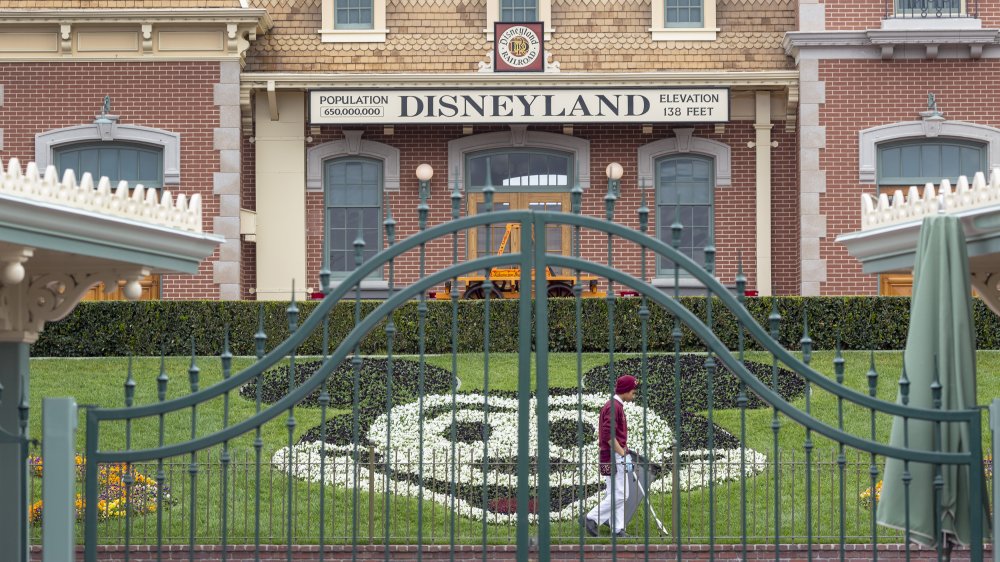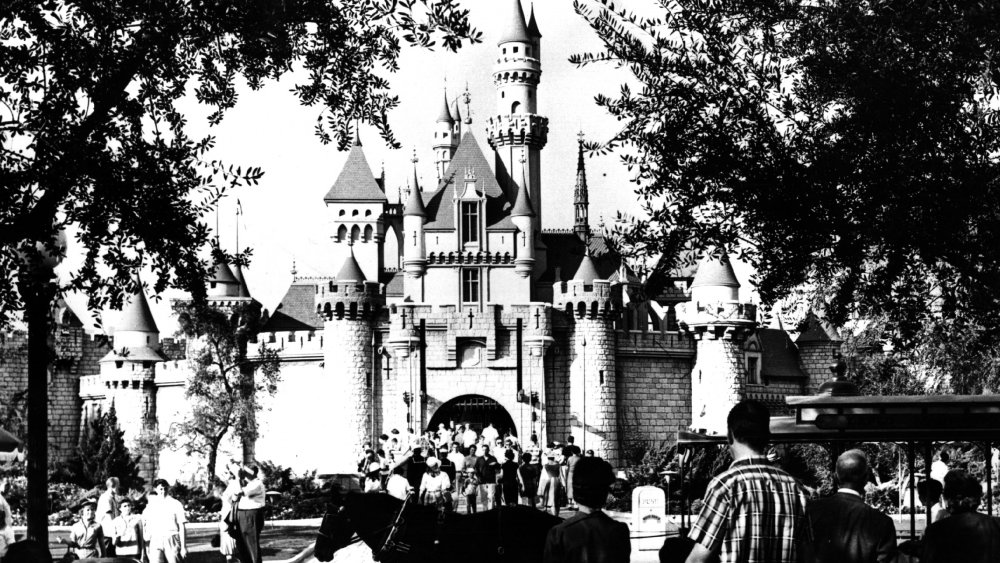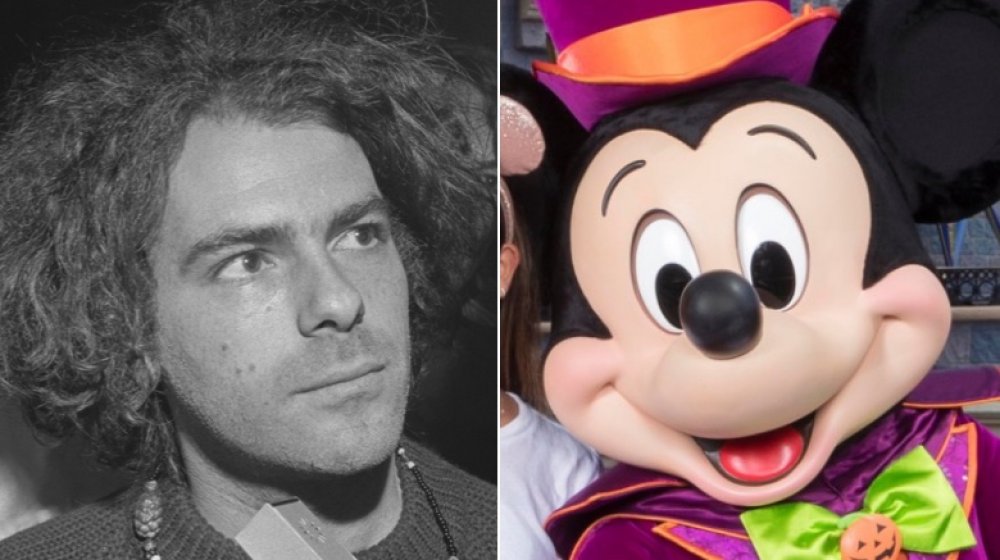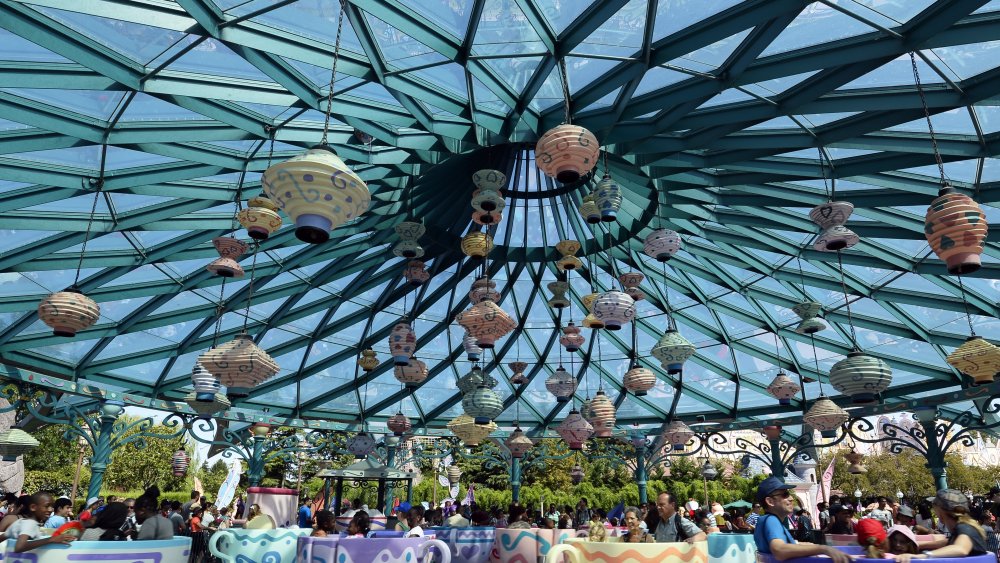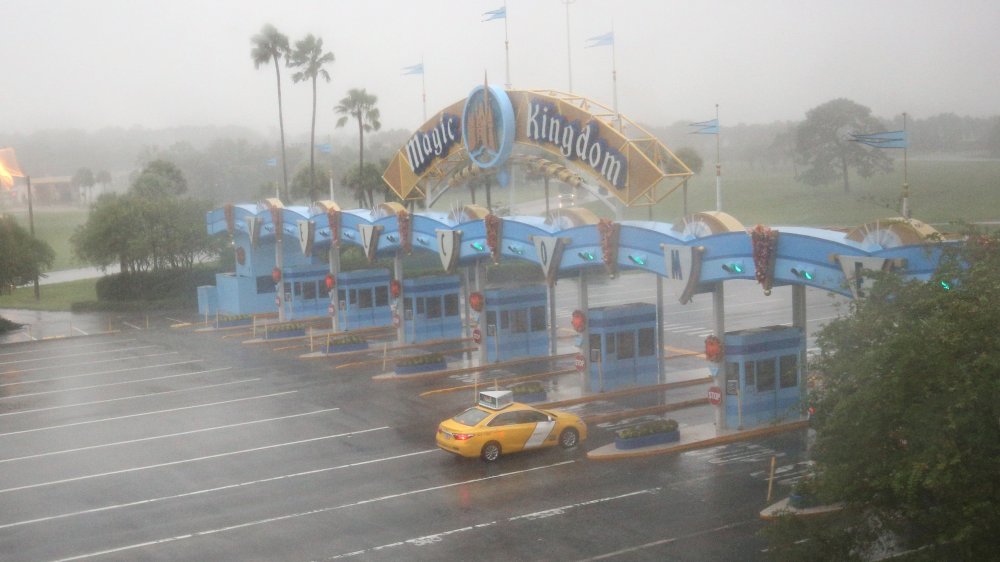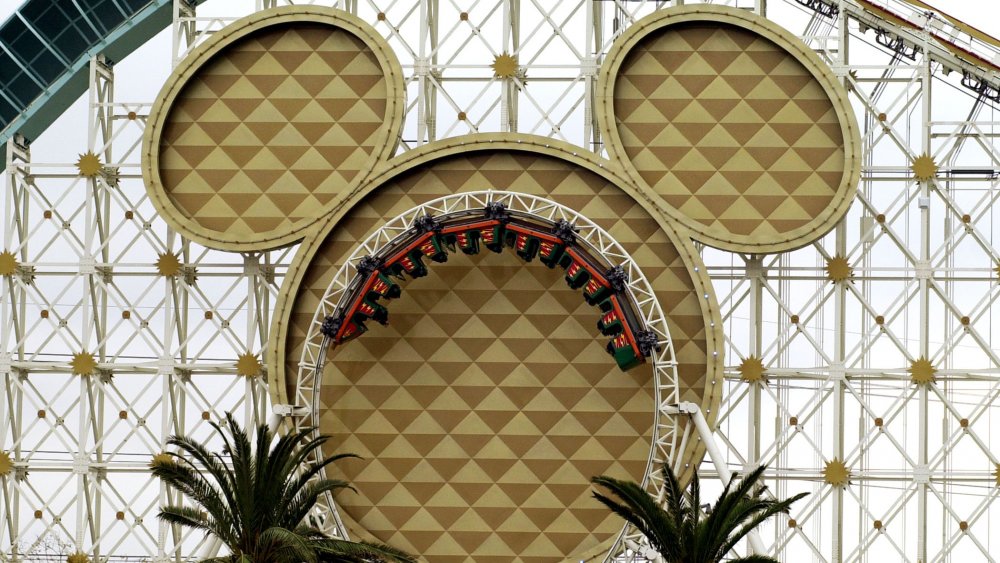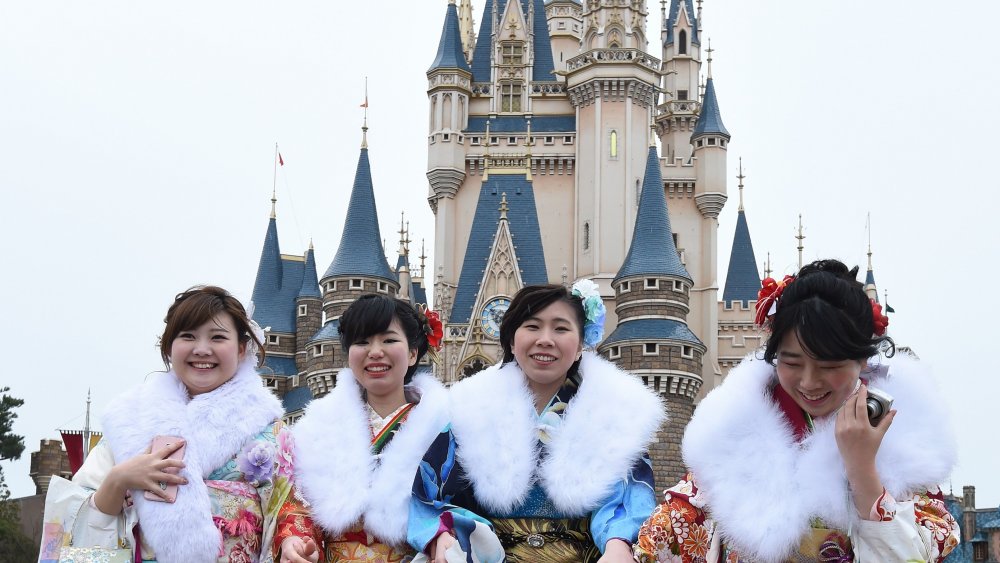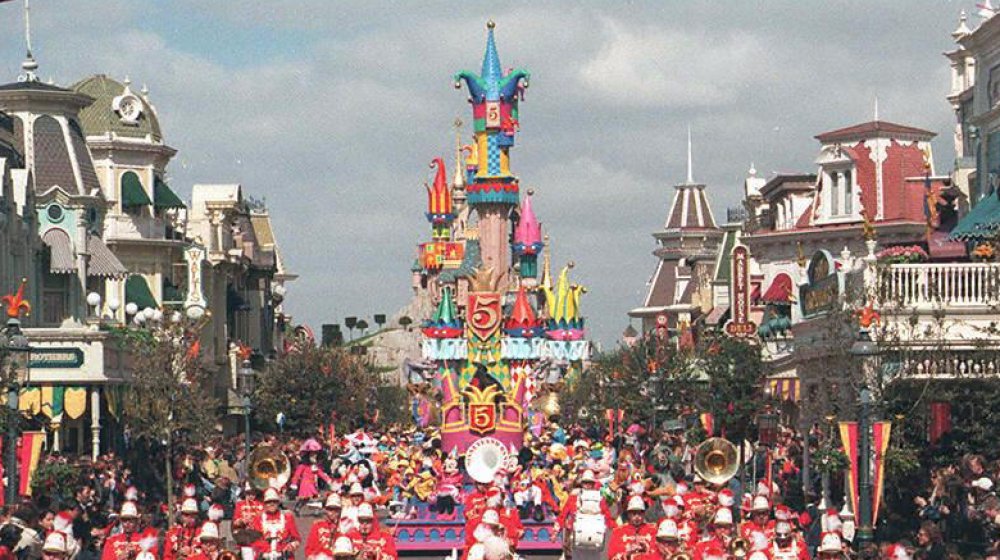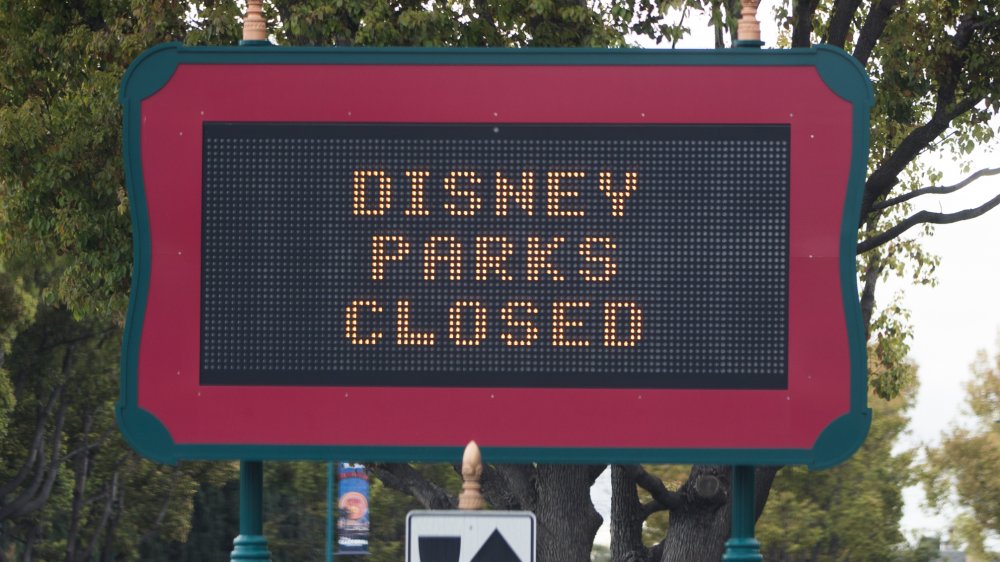All The Times The Disney Theme Parks Have Closed
Most every single day, year after year, all of Disney's many magical, enjoyable, sensory-overloading theme parks have thrown open their gates and invited in millions of people to have the day or vacation of their lives. Whether its Disneyland in California, the Walt Disney World Resort in Florida, or its satellite locations in Japan, France, and China, each park offers the full Disney experience, from up close and personal encounters with costumed Disney characters like Mickey Mouse, Buzz Lightyear, and Queen Elsa to thrill rides based on Disney properties including Dumbo and Guardians of the Galaxy.
But sometimes sadness, tragedy, fear, and caution can overcome even the joy and glee produced by "the happiest place on Earth," as Disney has long referred to its amusement facilities. Out of the thousands of days of highly profitable operations across its parks, the House of Mouse has only shut things down about a dozen times — and only when they had to, by decree of government, or in the interest of public safety or good taste. Here are all the times even a wish a heart makes couldn't get a person into a Disney theme park.
Disneyland closed the day after President John F. Kennedy was assassinated
Disneyland opened for business in July 1955, and it was an immediate success. During its years-long construction process, Walt Disney himself deftly promoted the show during his weekly anthology TV series Disneyland, ensuring huge crowds when the gates finally opened. Just a few weeks after opening, more than a million people had visited Disneyland. It enjoyed a perception as an ultra-happy, well-oiled machine, much like the United States as a whole enjoyed in the early 1960s, or the idealized "Camelot" era under young, optimistic president John F. Kennedy.
Then an ugly event destroyed those feelings and changed American history: On November 22, 1963, President Kennedy was assassinated while riding in a motorcade in Dallas. According to the Washington Post, Disneyland's operators decided to shut down the park for the following day, a Saturday. An employee was posted near the entrance of the empty Disneyland next to a sandwich board that read, "In observance of our national mourning, Disneyland is closed today." That marked the first time in history that the Disney park wouldn't open.
Disneyland evacuated guests in 1970 when a protest went sour
The Yippies were an aggressively political offshoot of the countercultural movement. These members of the Youth International Party, started by activists Jerry Rubin and Abbie Hoffman, were prone to dramatic public stunts to get across their anti-war, anti-establishment message. (For example, they once tried to get a pig named Pigasus nominated for president.) But the Yippies wanted its stunt on August 6, 1970 to be its most memorable to date.
According to Mouse Tales: A Behind-the-Ears Look at Disneyland (via Atlas Obscura), the Yippies chose a Disneyland protest because sponsor Bank of America also helped fund "war machines." The Yippies had a long list of plans for "International Pow Wow Day," including a Black Panthers-sponsored breakfast in the morning, a "rally to liberate Minnie Mouse" at noon, a symbolic feast of Porky Pig (who isn't a Disney character), and finally an occupation of Tom Sawyer Island.
Yippies talked up the protest in advance so much that police were well aware of the Disneyland plan by August 6 — a mob of officers were stationed outside the park, ready if needed. About 300 Yippies ultimately showed up to act out. While one group smoked marijuana on Tom Sawyer Island, another contingent marched down Main Street and provoked fights with other guests — which is when the police rolled in. Park management did its part, shutting down Disneyland for the day about five hours early, evacuating 30,000 people while the police put down the protests.
After earthquakes, Disneyland rides open individually after thorough inspections
Early in the morning of January 17, 1994, the earth shook and rumbled throughout the San Fernando Valley area of Southern California. What came to be known as the Northridge Earthquake was among the most devastating to hit the Los Angeles area in recent memory. According to The Atlantic, the 6.7-magnitude scale killed more than 60 people, injured around 9,000, and caused major damage — elevated roads cracked, gas lines caught fire, buildings collapsed, and large parts of the area lost power.
Such a day of death and destruction doesn't seem like the best time to visit Disneyland — or maybe doing so was a defiant statement about the triumph of humanity over nature and misery. The Anaheim, California-set theme park opened like normal just a few hours after the Northridge Earthquake, but it was hardly business as usual. Ride inspectors surveyed each ride for safety-compromising damage before they were individually cleared to open. That's pretty much what Disneyland does now in the event of an earthquake. A seismic event has never shut down the park entirely, but after quakes in 2010, 2014, and 2019, park employees checked all of the rides in Disneyland before allowing guests to board (or re-board, as the case may be).
Hurricanes have shut down Disney World relatively often
Disney expanded its theme park empire in 1971 with the opening of the Walt Disney World Resort outside of Orlando, Florida. The name "Disney World" technically refers to the sprawling entertainment complex, made up of affiliate destinations like Disney's Fort Wilderness, Epcot (which opened in 1982), and Magic Kingdom, the Disneyland-like theme park with all of the rides and suited characters. For more than a decade, nothing could stop this juggernaut of a tourist destination, until Mother Nature reminded Disney with alarming regularity that it had built theme parks in a hurricane zone.
On August 31, 1985, the Walt Disney World resort closed early due to Hurricane Elena, according to All Ears. In 1995, Disney World opened at 11 a.m., when it was safe to do so in the wake of Hurricane Erin. In September 1999, the threat of Hurricane Floyd led management to close Walt Disney World early one day and for the entirety of the following day. The 2004 hurricane season was especially battering, and it led to three brief closures over a span of two months. On August 13, Hurricane Charley meant an early closure for Walt Disney World. On September 4 and 5, Hurricane Frances shut down all the Florida parks, with a few staying closed on the 6th. On September 26, Disney World closed once more, this time due to Hurricane Jeanne. More recently, Hurricane Matthew shuttered Disney World on part of October 6 and all of October 7, 2016, and Hurricane Irma led to a two-and-a-half day lockout in September 2017.
Disney closed its American parks on 9/11
It's hard to think of a single worse day in American history than September 11, 2001. That morning, coordinated terrorist groups hijacked commercial airplanes. Two hit the towers of the World Trade Center in Manhattan, a third struck the Pentagon in Washington, D.C., and a fourth crash-landed in Pennsylvania after passengers overpowered their attackers. Nearly 3,000 people died as a result of the 9/11 attacks, and more than 25,000 were injured, not counting the many first responders at "Ground Zero" in New York who later died of respiratory diseases incurred from their search-and-rescue work.
The most significant attack on U.S. soil since the World War II-era bombing of Pearl Harbor in 1941, millions of Americans were left panicked and terrified, fearing more attacks on more public places. Shortly after the second plane hit the WTC, ABC News (via Huffington Post) announced that parent company Disney had closed down all of its theme parks around the world, including Walt Disney World which had already opened for the day. All rides, restaurants, and shops shut down, in order to get guests onto the roads and paths leading out of the park. (No mention was made as to why everything was abruptly closing up in the late morning.) Disneyland didn't open its gates at all on 9/11 — the attacks occurred so early in the morning that the closure could be arranged before guests started arriving.
A huge earthquake shuttered Tokyo Disneyland for weeks
An earthquake with a tremendous magnitude of 8.9 (according to the U.S. Geological Survey) occurred off the coast of Japan on March 11, 2011. The fifth-largest since 1900, the wreckage was both immediate and widespread. Underwater volcanoes lead to disturbances in the oceans, and those waves destroyed cars, ships, and beachside buildings. Tsunami warnings and evacuation orders were issued as far away as the west coast of the U.S., and the movement led to multiple meltdowns at the Fukushima nuclear power plant. According to the Japanese government, the earthquake and associated events killed nearly 16,000 people and injured more than 6,000.
Disney opened its first theme park outside of the U.S. in 1983: Tokyo Disneyland, a near-exact replica of its facility in Anaheim. An extremely popular tourist attraction, it was quite full when the earthquake hit: According to Australia's ABC News, about 69,000 guests were around when the park shut down mid-day. Fortunately, no major injuries or property damage went down, although the main parking lots were flooded. As so many cars were inaccessible, and a shelter in place order announced, thousands had to stay in Tokyo Disneyland overnight. The park remained closed for business for well over a month, re-opening on April 15.
Disneyland Paris shut down to observe France's national period of mourning
On November 13, 2015, Paris was bombarded by a series of six brutal terrorist attacks. The ISIS organization claimed responsibility for the coordinated efforts that pinpointed six locations around the French capital that left 130 dead and 494 wounded. Just after 9 p.m., a device exploded outside of the Stade de France, where the French national soccer team was playing Germany with President Francois Hollande in attendance. Within 40 minutes, two more explosions occur just outside the stadium. Meanwhile across town, gunmen with assault rifles killed 39 people in three near-simultaneous attacks on bars and restaurants. The final horrific event of the evening occurred when armed assailants entered the Bataclan concert hall and shot and killed 90 people attending an Eagles of Death Metal show.
With France left reeling and in a national state of emergency, operators at Disneyland Paris (formerly known as Euro Disney) elected to leave the park closed on November 14. "Considering the gravity of the events that occurred in France and by solidarity for the French government and the victims of these hideous attacks, Disneyland Paris has decided to not open," read an official statement (via Variety). The park ultimately stayed closed for four days.
Disney shut down all of its parks to slow the spread of the coronavirus
In early 2020, a respiratory illness known as the novel coronavirus, or COVID-19, spread widely and wildly. Notable for causing a fever, breathing difficulties, and a persistent dry cough, the coronavirus was declared a pandemic by the World Health Organization on March 11, 2020. At that time, 118,000 people in 114 countries had contracted the illness; by mid-April, those figures had ballooned to 2.6 million in 211 countries, with more than 136,000 deaths.
In efforts to limit the person-to-person spread of the coronavirus, numerous local and federal governments declared states of emergency and went into lockdown mode, issuing stay-at-home orders, banning events, and closing locales where large groups of people could gather — such as theme parks.
As the virus first took hold in China, the first parks to close down were Disney's facilities in that country. Hong Kong Disneyland and Shanghai Disneyland shut down on January 25, 2020. Tokyo Disneyland opted to temporarily end business as of February 28, and extended the closure on March 11. Over the next few days, as the coronavirus rapidly infected people in the U.S. and Europe, Disney parks in those locations locked the gates, too: Disneyland, the Walt Disney World complex, and Disneyland Paris. That meant all the Disney properties around the world, for the first time in history, were all closed to the public.
